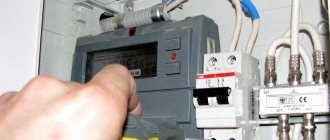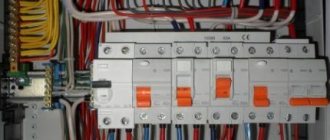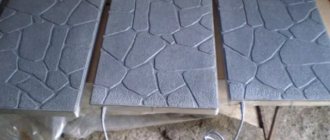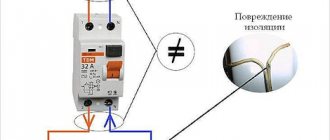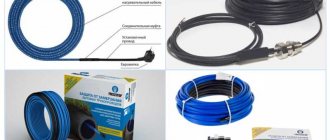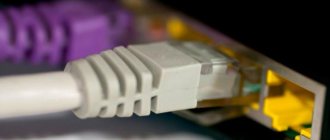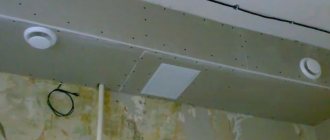For quite some time now, modern homes have stopped using corks. They were replaced by more technological devices - automatic machines, also known as baggers, although some still call them traffic jams, but this is wrong, because the operating principle of a traffic jam and a machine is somewhat different. Since in this article we will consider the selection of a machine depending on the cable cross-section, there will be no talk about traffic jams.
So, the machine is a device that allows you to open the electrical circuit automatically in two cases:
- line current overload;
- occurrence of a short circuit (SC).
In the first case, overload occurs due to a malfunction of electrical appliances or their large number and power density. In the second case, due to a short circuit, electricity is consumed to heat the wires with the maximum possible current for this section. In addition to the above cases of circuit breakage, the machine provides the possibility of manual control. There is a switch on the body of the device that allows you to open the circuit.
The purpose of the circuit breaker is to protect the section of the electrical circuit for which it is installed, as well as timely opening of this section in the event of an overload or short circuit.
Selecting a machine based on cable cross-section and load power
For quite some time now, modern homes have stopped using corks. They were replaced by more technological devices - automatic machines, also known as baggers, although some still call them traffic jams, but this is wrong, because the operating principle of a traffic jam and a machine is somewhat different. Since in this article we will consider the selection of a machine depending on the cable cross-section, there will be no talk about traffic jams.
So, the machine is a device that allows you to open the electrical circuit automatically in two cases:
- line current overload;
- occurrence of a short circuit (SC).
In the first case, overload occurs due to a malfunction of electrical appliances or their large number and power density. In the second case, due to a short circuit, electricity is consumed to heat the wires with the maximum possible current for this section. In addition to the above cases of circuit breakage, the machine provides the possibility of manual control. There is a switch on the body of the device that allows you to open the circuit.
The purpose of the circuit breaker is to protect the section of the electrical circuit for which it is installed, as well as timely opening of this section in the event of an overload or short circuit.
Unacceptable mistakes when purchasing
The most common mistakes when choosing and purchasing an input circuit breaker are ignorance of the principles of its operation and choosing a machine rating lower or higher than the required value. If you choose a machine with a lower rating, then it is possible that the protection will trigger falsely and shut down the entire apartment due to one device. If you select a rating higher than the required value, it may work after the wire insulation or devices inside the electrical panel overheat and begin to melt or burn.
There are also “professionals” who connect two single-pole circuit breakers instead of a two-terminal circuit, not knowing that this violates electrical safety requirements and the PUE prohibits such a connection.
If you have doubts about the selection and installation of such a device, you should contact a professional electrician and rest assured that the correct choice and safe installation.
How to calculate the power of a machine
In order to provide the most effective and accurate overload protection, the formula is used to calculate the machine’s power for a 220V network:
in which the rated current is expressed by I, the sum of the powers of all powered consumers including lighting devices is P, and the voltage of the electrical network is U. Thus, the value of the rated current will increase with an increase in the total power of consumers.
And for a 380V network, the power calculation of the machine is made according to the formula:
in which the cosφ value is added, meaning the power factor (the exact value can be found in Table 6.12 of the SP 31-110-2003 standard “Design and installation of electrical installations in residential and public buildings”). To simplify calculations in everyday conditions, cosine phi is taken equal to one. In general, this coefficient depends on the type of electrical receiver, for example:
- for lighting networks with fluorescent lamps, the power factor is 0.92;
- for lighting networks with incandescent lamps - one;
- for gas-light advertising installations - from 0.35 to 0.4;
- for computers without technological air conditioning - 0.65;
- for refrigerators and air conditioners with an electric motor up to 1 kW, cosφ is equal to 0.65, and with a motor of 1 - 4 kW, the power factor increases to 0.75.
Let's try to calculate the machine's power using an example. Let's say you are trying to protect a group of three kitchen outlets from short circuits. In one, a refrigerator with a power of 400 W is constantly turned on, in others, a microwave or kettle (1000 W) or a blender (300 W) is periodically connected. Let's calculate the total power if you want to simultaneously connect the most powerful devices: 400 + 1000 + 1000 = 2400 W. The current strength for a 220V network is as follows:
And we recommend choosing a machine based on power in favor of the closest 10A rating. A natural concern may arise: will it “knock out” when applying more voltage to such a nominal value? In fact, if you apply a load of 15 amps to a 10-amp protective device, the operation will occur in eight minutes, and if you apply 11 amps, then it will take as long as twenty minutes. During this time, the kettle will turn off and the load will again become acceptable - much earlier than the release switches on.
How to choose a circuit breaker in the case of a three-phase input, which is relevant for private houses and some new buildings? You can either use the power factor formula or refer to the table.
What is it needed for
The machine is considered a device whose main task is to ensure safe use of the electrical network. He also deals with protecting equipment from overcurrent, which is considered an overload short circuit. Such equipment is turned on and off from an electrical circuit. It is equipped with either an electromagnetic release or a combined type. Thanks to this, the circuit can be protected. Its main advantage is the fact that it allows you to protect an electrical installation or transformer substation from short circuits, network overloads and breakdowns as a result of frequent network outages.
Network protection as the main task of a circuit breaker
It has on its body markings of the rated current, switching capacity, current limiting class, rated breaking capacity and time-current response characteristics of the release system. It can be single-pole, two-pole, three-pole and four-pole and is suitable for the network phases corresponding to the name.
Important! Most often it is used to protect an electric stove or other kitchen heating appliances. It is also used to protect the lighting system with motor and transformer systems
Cables GOST 31996–2012
When choosing a machine, it is necessary to take into account the characteristics of the cables. The most important is the permissible current (Iperm). It shows at what maximum current the cable can operate throughout its entire service life. This table from the PUE contains information about permissible cable currents depending on the material and conditions of cable laying.
Permissible currents for cable depending on materials
| Open wiring | Cable cross-section, mm2 | Closed wiring | ||||||||||
| Copper | Aluminum | Copper | Aluminum | |||||||||
| Current A | Power, kWt | Current A | Power, kWt | Current A | Power, kWt | Current A | Power, kWt | |||||
| 220 V | 380 V | 220 V | 380 V | 220 V | 380 V | 220 V | 380 V | |||||
| 11 | 2.4 | — | — | — | — | 0.5 | — | — | — | — | — | — |
| 15 | 3.3 | — | — | — | — | 0.75 | — | — | — | — | — | — |
| 17 | 3.7 | 6.4 | — | — | — | 1 | 14 | 3 | 5.3 | — | — | — |
| 23 | 5 | 8.7 | — | — | — | 1.5 | 15 | 3.3 | 5.7 | — | — | — |
| 26 | 5.7 | 9.8 | 21 | 4.6 | 7.9 | 2 | 19 | 4.1 | 7.2 | 14 | 3 | 5.3 |
| 30 | 6.6 | 11 | 24 | 5.2 | 9.1 | 2.5 | 21 | 4.6 | 7.9 | 16 | 3.5 | 6 |
| 41 | 9 | 15 | 32 | 7 | 12 | 4 | 27 | 5.9 | 10 | 21 | 4.6 | 7.9 |
| 50 | 11 | 19 | 39 | 8.5 | 14 | 6 | 34 | 7.4 | 12 | 26 | 5.7 | 9.8 |
| 80 | 17 | 30 | 60 | 13 | 22 | 10 | 50 | 11 | 19 | 38 | 8.3 | 14 |
| 100 | 22 | 38 | 75 | 16 | 28 | 16 | 80 | 17 | 30 | 55 | 12 | 20 |
| 140 | 30 | 53 | 105 | 23 | 39 | 25 | 100 | 22 | 38 | 65 | 14 | 24 |
| 170 | 37 | 64 | 130 | 28 | 49 | 35 | 130 | 29 | 51 | 75 | 16 | 28 |
From this table you can find the required cable cross-section and permissible current depending on the wiring conditions, open or buried. For example, the power of all appliances in the apartment is 9 kW. For open single-phase copper wiring, the wire cross-section is 4 mm 2, current 41A, for closed - the nearest higher power value is 11 kW, cross-section 10 mm 2, current 50A. The nearest lower rating of the circuit breaker is 32A.
If there is doubt about the quality of the electrical wiring, then it is better to exercise caution and choose a machine with a rating lower than the value in the table.
The residential network has a branched structure: a current of different strength will flow in each branch, so the wires have different cross-sections. If you install one circuit breaker only at the entrance, it will not be able to protect individual sections of the wiring from overload. If the entire network is laid with a cable of the same cross-section, then this is an unjustified financial expense. The best solution would be to install the appropriate current on each section of the machine. The figure shows an approximate structure.
Installation of machines for the appropriate current
The figure clearly shows the load on each section and the cross-section of the wire. By installing appropriate circuit breakers, you can reliably protect the entire network from short circuits or overloads. In addition, at any time it is possible to select and disable one or another section, maintaining the functionality of the rest of the network.
When using powerful asynchronous motors in everyday life, especially 3-phase ones, for example, power tools, it is advisable to turn them on through a separate circuit breaker, since they have a large starting current, and when operating through a common circuit breaker, a power outage may occur even during normal operation of the equipment.
A little theory
W = I x V (1)
where W is the current power in watts (W);
I – current strength in amperes (A);
V – voltage in volts (V).
I = W / V (2)
I = 6000 W / 220 V = 27.3 A
I = W / 1.73V (3)
I = 6000 W / (1.73 x 380 V) = 9.1 A
Having received this indicator, you can begin to select a circuit breaker that provides network overload protection.
What determines the choice of cable cross-section?
The main task of preserving the original functionality of an electrical cable is to prevent it from overheating. This can be solved very simply if 1 mm2 is subjected to a load in the form of a long-term total current not exceeding 9 Amperes. When translating this indicator into a more familiar value for the average person - power, it turns out that a conventional cable with a cross-section of 1 mm2 can be used to power electrical appliances with a power consumption of up to 2 kW. If such numerical transformations cause difficulties, and a special online calculator
is not available at the right time, you just need to remember a few simple rules.
- Cable for lighting – core cross-section 1.5 mm2.
- Cable for all sockets, air conditioning, loggias - core cross-section 2.5 mm2.
- Cable for electric ovens – core cross-section 4 mm2.
- Cable for hobs and instantaneous electric water heaters – core cross-section 6 mm2.
Important! The cable supplying outlets and lighting systems may break, have branches and connections. And all others from the list presented above must be solid. This means that to organize power supply for, say, an oven, a special line of cable with a cross-section of 4 mm2 must be laid directly from the panel, and with the installation of a separate machine. This is a standard and there is no situation that would allow us to deviate from it and organize branches to power other power devices. Any joint on such a line is a minus to durability and reliability.
Performance
Its service life largely depends on how quickly the switch turns on and closes its contacts. However, is it possible to determine at home how well your device corresponds to this parameter without disassembling the case itself and without resorting to specialized laboratory tests?
Of course you can. Everything is done very simply. Take a regular battery-powered indicator screwdriver. Exactly with the battery.
It is usually used for testing and determining the integrity of the circuit. Although knowledgeable people use this useful device in many other ways. Read about which ones in a separate article.
Use the tip of a screwdriver to touch the upper contact, pressing the metal patch on the handle from above, and with the finger of your other hand, touch the lower contact of the switch.
After which, you slowly begin to turn on the machine, cocking the tongue.
The contact should appear (the LED in the screwdriver will light up) only at the very last moment, when the device has already clicked.
If the same manipulation is done with another switch, the light comes on when the power lever reaches the middle of the stroke.
It turns out that the device is not yet cocked, but the contacts are already closed. This is what this sometimes leads to under heavy load (view of the contacts from inside the machine):
This ultimately affects the rapid wear and burnout of contacts. While the quick-start mechanism increases the service life of the product by almost 30%.
Application of measuring instruments
To determine the diameter of the cores of wires and cables, various measuring instruments are widely used, showing the most accurate results. Basically, the use of micrometers and calipers is practiced for these purposes. Despite their high efficiency, a significant drawback of these devices is their high cost, which is of great importance if the tool is planned to be used only 1-2 times.
As a rule, professional electricians who are constantly engaged in electrical installation work use special devices. With the right approach, it becomes possible to measure the diameter of wire cores even on working lines. After obtaining the necessary data, all that remains is to use a special formula:
The result of the calculation will be the area of the circle, which is the cross-section of the wire or cable core.
Principle of operation
The main element of the device is an electromagnetic one with a thermal release. The first guarantees protection against short circuits, the second - against overvoltage. An electromagnetic device is a coil with a core, which is placed on a special spring and, under normal conditions, creates an electromagnetic field that attracts the coil core.
The heating unit comes into operation when an overload occurs. This is a bimetallic strip with metal A and B.
Important! At the moment of overvoltage, current flows to the plate, it heats up and, due to the property of B to expand, the surface bends and the movable type of contact opens.
The principle of operation of any circuit breaker
Which machine to choose for 2.5 mm2 cable?
For consumers whose total power will not exceed 3.5 kW, we recommend using a copper cable with a cross-section of 2.5 sq. mm and protecting these lines with a 16A automatic.
For a copper cable with a cross-section of 2.5 sq. mm according to Table 1.3.6 of the PUE, the long-term permissible current is 27A. Based on this, you might think that a 25A machine will fit such a cable. But that's not true. By the way, for those who don’t know where to look, I publish this table:
According to the PUE, clause 1.3.10, a current value of 25A will heat up a 2.5 sq. mm cable to 65 degrees Celsius. This is a high enough temperature for constant operating modes.
It is also important to understand that not all manufacturers produce cables in accordance with GOST and its cross-section may be lower than declared. So the cross section could be 2.0 sq.mm instead of 2.5 sq.mm. The quality of copper also differs between factories and you cannot be guaranteed to accurately say what quality of cable you have.
Therefore, a reserve in cable protection is very important to avoid problems during the operation of electrical wiring. The choice of machine according to the cable cross-section is carried out as follows:
- I use a 1.5 sq. mm cable when installing alarms and lighting; it corresponds to a 10A machine;
- a 2.5 sq. mm cable is often used for individual sockets and socket groups, where the total power of consumers will not exceed 3.5 kW. It corresponds to the current ratings of 16A automatic machines;
- a 4 sq. mm cable is used in everyday life to connect ovens, washing machines and dishwashers, heaters and water heaters; they buy a 25A automatic machine for it;
- a 6 sq. mm cable is needed to connect serious powerful consumers: electric stoves, electric heating boilers. Machine rating 32A;
- a cable of 10 sq. mm is usually the maximum cross-section used in everyday life, intended for supplying power to apartments and private houses to electrical panels. Automatic 40A.
To calculate the electrical network at home, boldly and strictly follow the table and guide provided above. With the correct calculation of power lines and protective devices, everything will work for a long time and will not bring you any inconvenience or problems.
Automatic switches (bags, automatic machines, DIN-rail automatic circuit breakers)
Automatic switches are used for switching electrical networks, protecting them from short circuit currents and overloads. In everyday life, modular machines with standardized dimensions are used.
Design of modular machines
Modular circuit breakers are assembled in housings made of dielectric materials, the width of which is a multiple of 17.5 mm. Inside the case there are:
- lever release mechanism;
- electromagnet coil;
- moving and fixed contacts;
- arc extinguishing device;
- bimetallic plate;
- screw terminals for connecting wires.
The case contains fastening elements for a DIN rail, a manufacturer's logo, and inscriptions with the main characteristics.
The machine is turned on/off by a release mechanism when the lever is pressed. At a current exceeding the rated current by 13–45%, the bimetallic plate heats up and after some time breaks the circuit. In the event of a short circuit, the electromagnet rod acts on the release device and the machine turns off almost instantly.
The best domestic manufacturers
The user rating of machines for electrical wiring in the apartment also presents domestic models. The Top 5 manufacturers include:
1st place – Contactor
The devices have protection against excess power, are easily installed in a panel, a separate housing, and can be covered with casings. Current parameters depend on the series. VAZ is designed for 250 A, Proton - for 1600 A, Electron - for 6.3 kA. The household circuit breaker "KPRO" has a current strength of up to 100 A.
- adjustment against overload and short circuit;
- engraving on the case;
- good equipment protection.
- few household models;
- risks of electric shock from open contacts.
2nd place – Korenevo
Low-voltage equipment is designed for 1-3 poles, has a rated voltage of 230-600 V. Each brand product is reliable and operates without failure for 1000 cycles.
- full compliance of products with GOST standards;
- quality is above average.
one household series - VNK.
3rd place – DEKraft
The main production is concentrated in China, but the company was included in the rating of manufacturers of RCDs and automatic machines due to the affordable cost of goods. Models are designed for 6000 cycles. Disconnection of the circuit when the wiring overheats and restoration is carried out 25 thousand times.
- testing of machines in German TUV centers;
- wholesale sales from warehouses in Yekaterinburg and Moscow;
- Russian signatures on the position of the handle.
- current rating 63 A;
- input for cable type with cross-section up to 25 mm2.
4th place – KEAZ
The manufacturer from Russia has been operating for almost 75 years. Standard automatic devices and RCDs are represented by the KEAZ line, the latest devices are represented by the KEAZ Optima series. All devices are designed for direct and alternating current.
- you can purchase additional equipment - signal modules, releases;
- compactness.
- expensive cost of Optima series devices;
- The warranty period is from 12 to 24 months.
5th place – IEK
A Russian company that produces 4,000 products in Chinese factories. Modular devices have a current rating of 0.5-64 A, suitable for classes B, C and D. The indicator windows are marked in red and green.
- affordable price;
- durable body;
- mechanical and electromagnetic actuation system.
- Marriage often occurs;
- there is no assembly in Russia;
- minor burning due to short circuits.
